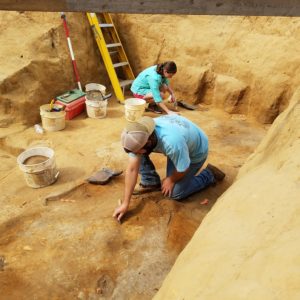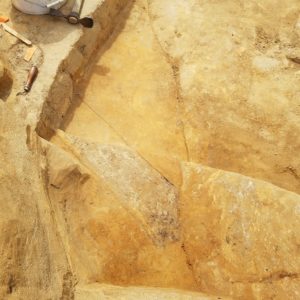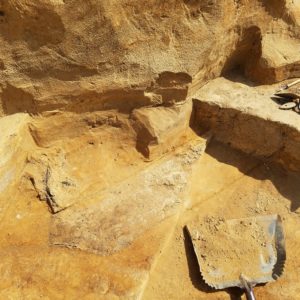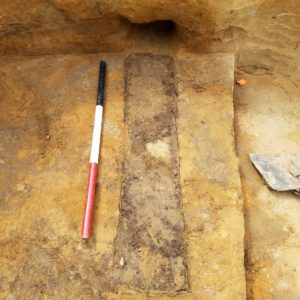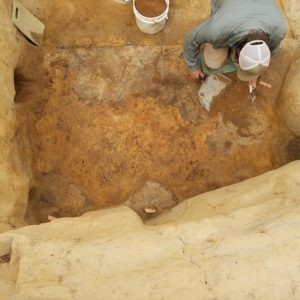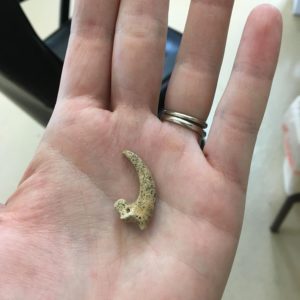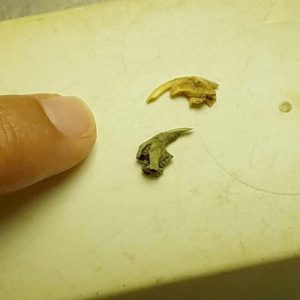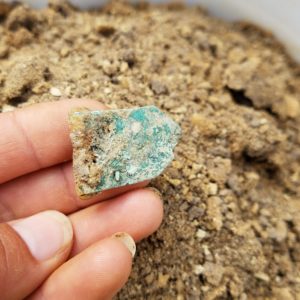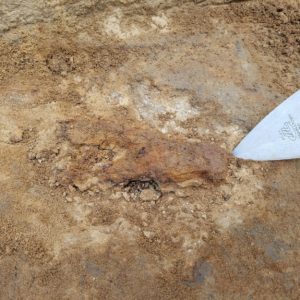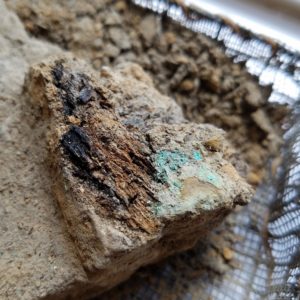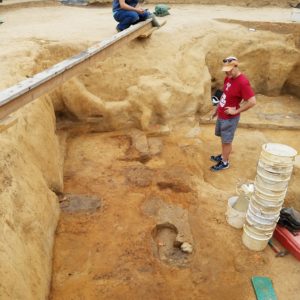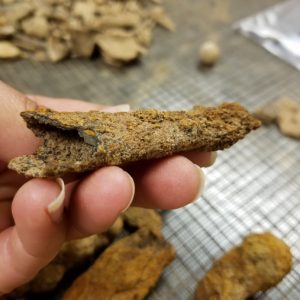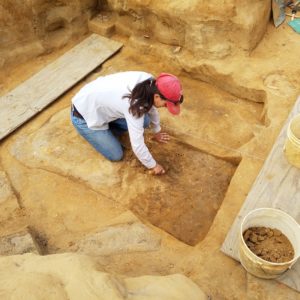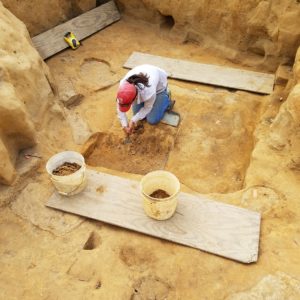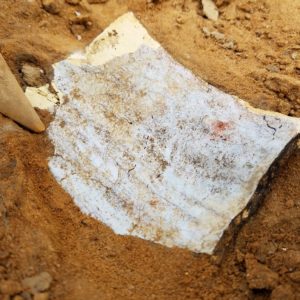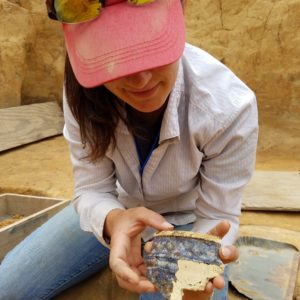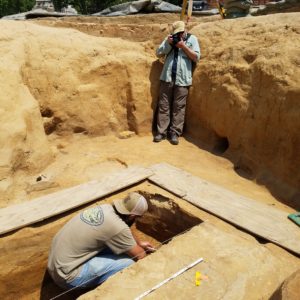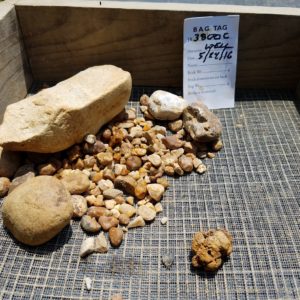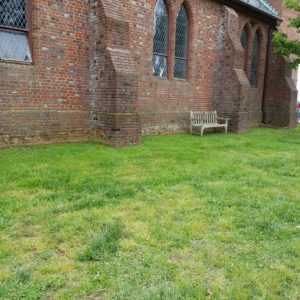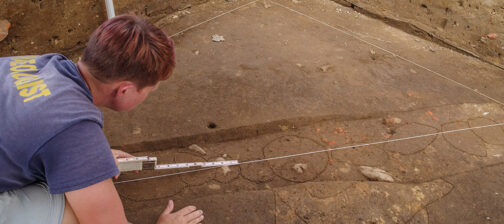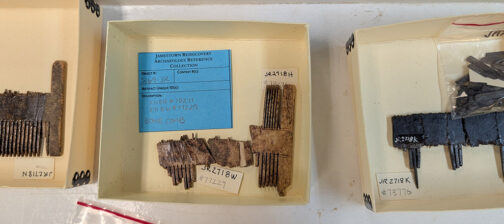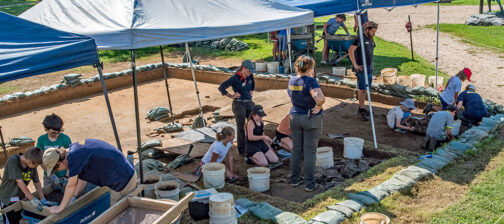During the first couple of weeks of May, the Rediscovery team focused on excavating the occupation layer in the cellar located at the northeast corner of the James Fort 1608 extension (Structure 193). Comprised of a mixture of clay, loam and sand, this layer capped almost the entire cellar floor. While removing the stratum, several shallow channels carved along the subsoil floor in the north area of the cellar were revealed. This is where water leaked into the cellar from above and eroded the floor during the building’s use. Because the natural subsoil at the floor level is comprised entirely of compact sand, any moisture would have softened the surface and made walking difficult. The channels appeared to lead toward the backfilled well shaft in the east side of the cellar. In this scenario, the backfilled well functioned as a sump, although perhaps an unintended one. The additional two to three inches of clay and loam spread over the subsoil floor may have been an attempt by the colonists to level the floor by covering those erosion channels.
“It is possible that a couple of the other pits we’ve identified cutting the cellar floor were attempts to give water an alternative place to collect other than the backfilled well shaft. We may discover that they were used as sumps sometime during the life of the cellar,” archaeologist Mary Anna Hartley speculates.
While screening the material in the cellar’s occupation layer, archaeologists noticed a striking difference between the few inches of occupation layer and the trash layers that had backfilled the cellar. The amount of faunal remains increased significantly, and included: sturgeon, turkey, duck, birds of prey talons, and rodents. Also found were copper scrap fragments, a copper alloy book clasp, and an iron shot mold for manufacturing lead musket shot.
Small fragments of wood survived only because they were in contact with copper scrap. Archaeologist Bob Chartrand pedestaled some of the wood and copper in the field for removal to the lab. Survival of buried wood for 400 years is rare, but as conservator Dan Gamble explains, “The copper salts from the copper scrap adjacent to the wood helped preserve it. However, it is too early to ascertain what the wood fragments are from.”
Finally, an interesting iron scabbard chape was found in the cellar’s occupation layer. This object is the terminal of a sword scabbard, or sheath, which was probably constructed of leather-covered wood. Made of sheet iron, the chape was formed by rolling an iron plate and brazing it at the joint.
An entire year after discovering it, excavations of the cellar well finally began in May! Archaeologists bisected the 5′ by 5′ square feature, digging the top 2 feet of the eastern half. Consisting of clay, loam, and sand, the first layer was used to raise the floor in the cellar’s east chamber to the level of its western side. As the backfill in the well settled, this top layer slumped toward the feature’s center. Artifacts in the first layer included a couple of scrap copper fragments, bird bones, and a section of a delft drug jar. This vessel is larger in capacity than those previously recovered in the cellar trash layers above.
The second well layer was an orange sand and clay layer devoid of any artifacts. It appeared to be redeposited subsoil likely obtained nearby, and it was heavily packed into the well shaft. Only well-rounded or well sorted stones were present. These stones appear to be fluvial rocks, also known as river rocks, which were naturally deposited in the subsoil sands and silt and originated a couple hundred miles upriver. Thus, they were in the subsoil that was excavated by the colonists and redeposited in the well. It appears likely that the subsoil was dug from one of the clay walls in an effort to expand the cellar while simultaneously backfilling the well. For now, excavations are paused as archaeologists decide how to best reinforce the well shaft, and also turn their attentions to teaching the 2016 Jamestown Rediscovery Field School.
related images
- Staff archaeologist Bob Chartrand and intern Kaitlyn Fitzgerald remove the two inches of occupation layer from across the floor of the cellar’s north side.
- The soil stain for the well shaft appears to either cut the soil stain for a wooden beam or board to the left or the wood board respects the well limits.
- A wooden beam stain in the layer of fill covering the well and raising the floor level in the eastern chamber. The beam may have been secured in the slot in the south wall.
- Part of the soil stain for a beam in the subsoil floor. Appears cut by the well shaft.
- Bob Chartrand excavates the layer of fill used to raise the east chamber floor to the level of the west chamber.
- Talon found in the occupation layer of the cellar.
- Rodent jaws found in the occupation layer of the cellar.
- Copper alloy book clasp found in the cellar fill.
- Iron shot mold used to manufacture lead musket shot.
- Wood found in the cellar. The salts from the copper scrap pieces next to the wood helped preserve it.
- Archaeologists Danny Schmidt and Don Warmke stand on the north side of the cellar after the removal of the occupation layer.
- Scabbard chape found in the cellar’s occupation layer.
- Archaeologist Mary Anna R. Hartley starts bisecting the well. Viewed from the east.
- Bisecting the well. Viewed from the north.
- The interior of a delft drug jar in situ in the top layer of the well.
- Mary Anna Hartley holds the delft drug jar after it was removed from the top layer of the well.
- Bob Chartrand digs in the well while volunteer archaeologist/photographer Chuck Durfor captures some images.
- Some fluvial rocks, found in the layer of redeposited subsoil composing the well’s second layer.
- The 2016 Jamestown Field School will explore the area just north of the Memorial church this June and July.



